Nixeus VUE 30: 30" 2560x1600 IPS Monitor Review
by Chris Heinonen on August 20, 2013 6:00 AM ESTTested using the Leo Bodnar lag tester, I measured 29.23ms of lag with a 1080p signal on the VUE 30. TO use the Leo Bodnar I average the three areas of the screen; top, middle, and bottom, that it can provide data for. With the VUE 30 the Top and Middle were both really low, at 21.6ms and 27.5ms, but it jumped up to 38.6ms at the bottom. I usually see variations of around 7-8ms between the areas, or roughly half the 16.7ms it takes to move between frames, but not a spread of 6ms and then 11ms.
Despite that weird measurement, I didn’t see any tearing or anything else that might be an issue when using the Nixeus for gaming. I’ll just chalk it up to some slightly strange behavior with the scaler and its timing, but not something that I could actually see a problem with. Note also that lag might be lower running at the native 2560x1600, but I can't directly compare that with most other displays as they lack support for that resolution.
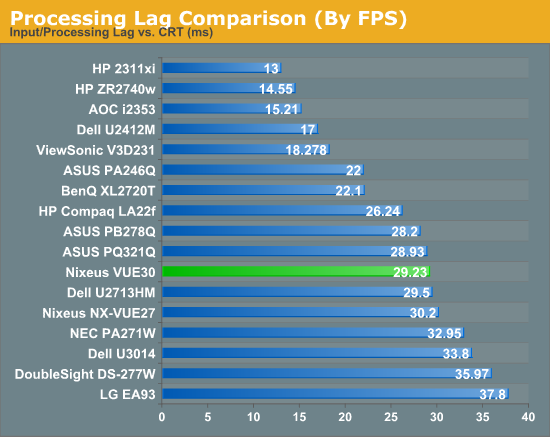
Power use is not a good area for the Nixeus. It is rated for < 130 watts of power consumption on the specs, but my unit managed to use over 150 watts at peak brightness. Since the peak brightness was also almost 75 cd/m2 below the specs, that is a large difference there in the power measurements. A white screen also uses less energy than a black screen with an LCD typically, so I’m not sure what would provide a power measurement that low while running at maximum brightness. Most likely Nixeus is rating power use by how much the display requires and not accounting for the efficiency of the power brick; 85% efficiency at 130W would give us 153W, which is close to what I'm seeing, but it's still quite a bit higher than a modern LED backlit display.
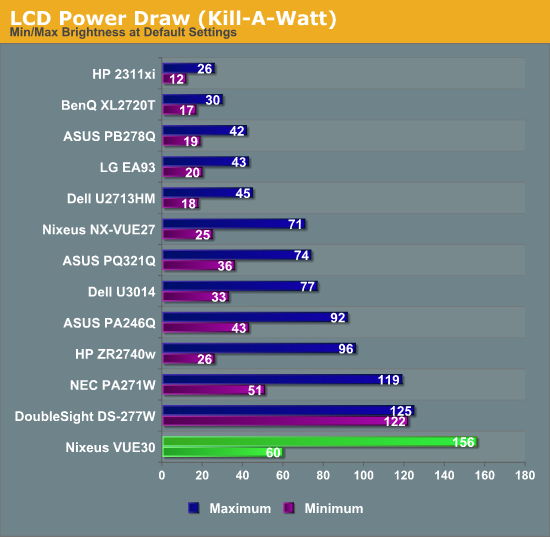
Going down to minimum brightness drops the power use to 60 watts, which is much more reasonable. Using my formula to get candelas per square inch per watt, the Nixeus came in dead last among the displays I have tested. All of the 30” displays do poorly here, as their more complex backlighting systems use a lot more power, but the Nixeus is the worst offender.
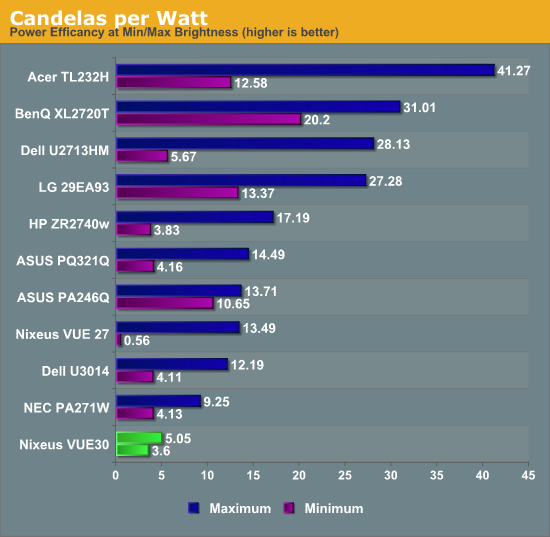
Running the Nixeus profile through Gamutvision, we see 103% coverage of the AdobeRGB gamut. This falls short of some other displays, but still is full coverage and as we saw it works pretty well when in AdobeRGB mode.
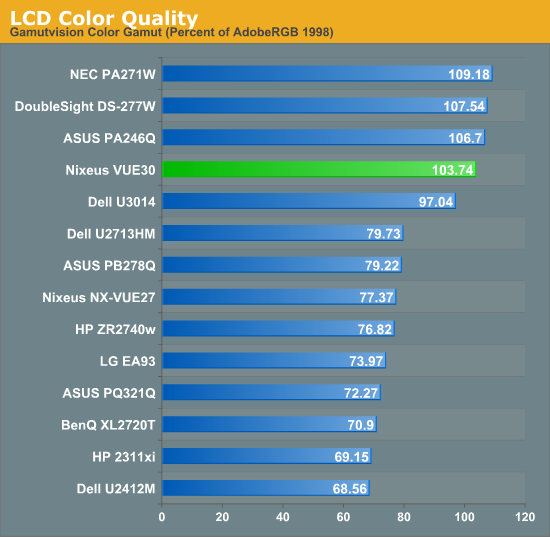
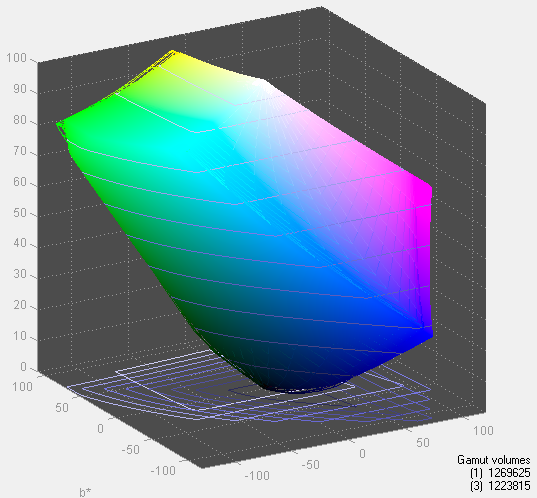


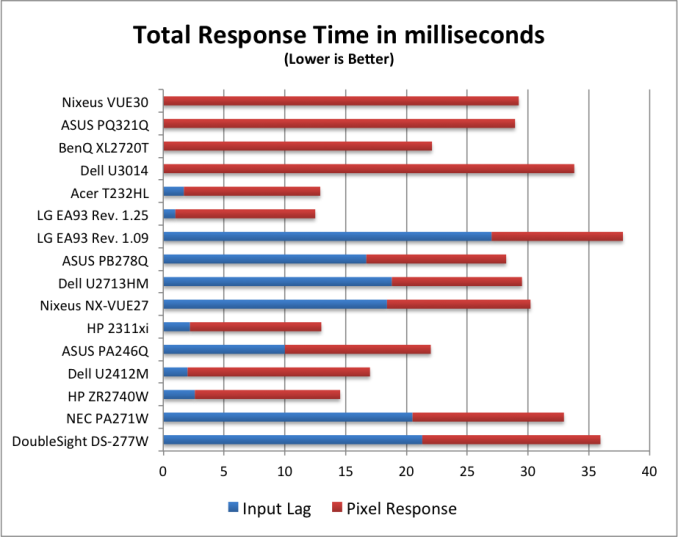








95 Comments
View All Comments
1Angelreloaded - Thursday, August 22, 2013 - link
uhm how can I break this down for you Photography and Filmography are used professionally on these monitors so MS plays a huge roll in ghosting during the film, so yes it does matter considerably, and this day in age people hybrid their workstations so they can game and do pro work on them, hence Nvidia released the Titan to fill that market, 1k for a hybrid workstation/gaming card is amazing.purerice - Wednesday, August 21, 2013 - link
To rephrase what Sancus said, there are two types of customers for >27", >1440p monitors: those who need high refresh rates and those who need high color accuracy. The intended market for the VUE 30 is the high color accuracy market.Asmodian - Tuesday, August 20, 2013 - link
The now discontinued LG W3000H had low input lag due to the lack of OSD and only one input (DVI-DL). It also has a wide gamut and mine has an uncalibrated white point of around 9000K (due to extra green instead of blue). Odd how no one seems to care about input lag on 16:10 displays anymore. Only 16:9 for gaming I guess. :(rtho782 - Tuesday, August 20, 2013 - link
My Dell WFP3007-HC has almost no input lag. The advantage of having a 30" from the days before there were any image processing chips available for 2560x1600 :PSodaAnt - Tuesday, August 20, 2013 - link
I used a dell u3011 for quite a while, which I believe has similar input lag, and I never noticed a thing in gaming. I think its just another tiny lag, keep in mind it isn't even two frames at 60 fps, and if you're running at 30 fps its not even a single frame of lag, so I doubt most people would notice it in gaming.oobble - Wednesday, August 21, 2013 - link
That is completely untrue. Most 2560x1440 27" monitors have an input lag of around 7ms.blackoctagon - Thursday, August 22, 2013 - link
Was that a reply to me? If so then what you state is incorrect, or you otherwise are referring to input lag in a different form to me. What matters is TOTAL monitor latency (a product of 'input lag' as well as pixel response time and processing time). Total latency on most IPSs is not appropriate for fast motion shooters, even though there are a select few IPSs that have low input lag, or have high refresh rates. In any case, this Nixeus is not one of these select few and is appropriate for graphics/photo design work rather than gaming.AnnonymousCoward - Thursday, August 22, 2013 - link
I think the latest Dell 30" has a game mode with sub-16ms lag. This is critical to me for ALL computer usage.Soldier1969 - Friday, August 23, 2013 - link
Uhm spoken by someone that clearly can't afford one or never used one. Only read about them I guess. Ive been gaming on a HP ZR30 for 3 years now very happy with the clarity and shooting motion but thanks nice try.ZeDestructor - Tuesday, August 20, 2013 - link
Same range as on every top-end "professional-use" wide-gamut panel. My U2410s have similar, and my 2408 is far worse at 64ms overall. All of those are eminently good for gaming. If anything, I prefer them over any fast TN because of the nicer colours. Really helps immersion :D. Sucks a bit for online p,lay though, but until eDP-based panels become a major thing, we'll still have input lag from scalers and whatnot, and in any case, you can't go below the panel response.